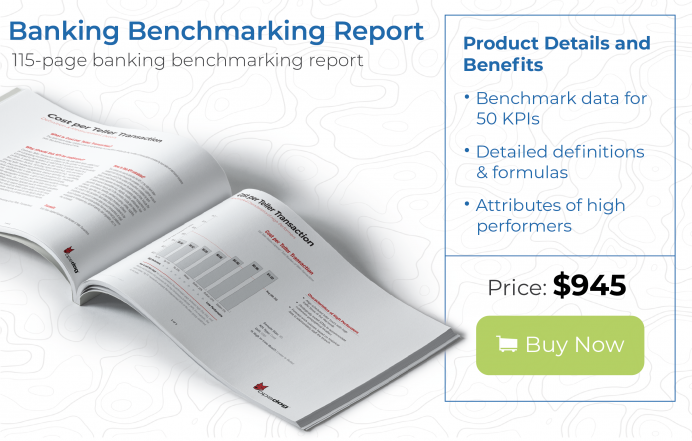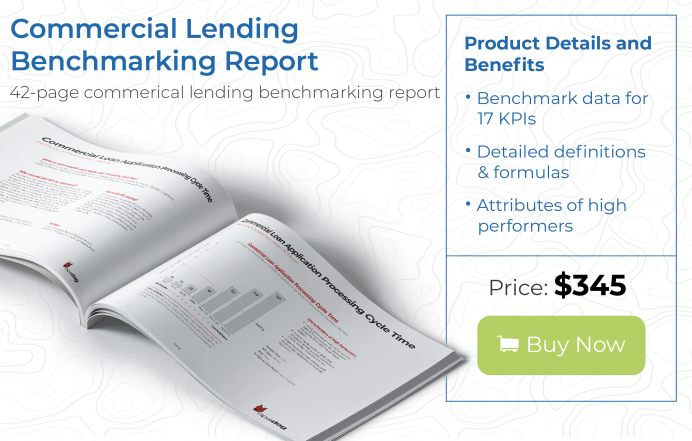Commercial loan officers may be the face of the lender but other lending professionals, including underwriters and credit analysts, can also impact the borrower’s experience as well as the profitability of the overall commercial loan portfolio.
What are Commercial Banking Loan Officer Key Performance Indicators (KPIs)?
Since personnel-related costs tend to be the bulk of your commercial loan origination costs, it makes sense that you’ll want to keep your staffing as lean and mean as possible. But downsize headcount too much, and you’ll face a backlog of loan applications in the pipeline and scores of unhappy borrowers.
Key performance indicators (KPIs) can help you find that happy balance.
Counting the number of lending professionals on your team is one metric that you can use, but most important is how efficient and productive those employers are. KPIs can measure your team’s performance, enabling you to pinpoint specific areas that are negatively impacting overall commercial lending. You can then work to identify the root causes, such as inadequate training or experience, too many manual steps, cumbersome and non-integrated technology, or the lack of easy-to-use job aids.
Why You Should Track Commercial Banking Loan Officer KPIs
Tracking commercial loan officer KPIs can improve the performance of your entire commercial lending operation, highlighting areas that need attention and then measuring the results of any changes.
For instance, by measuring how long it takes you to underwrite a commercial loan, you can better understand how well your internal teams of loan officers, underwriters, and credit analysts communicate and collaborate with each other. You can also identify bottlenecks and disruptions to workflow such as having to reach out to borrowers to gather more information, or overwhelmed credit analysts who are slowing down the underwriting process.
Once identified, there are lots of ways to mitigate these bottlenecks. For instance, rather than sending a loan application to the next available underwriter, triage applications and send the most complex applications to more experienced underwriters. Or, create electronic checklists so employees know the status of the loan—and can easily relay that status to borrowers.
Lack of communication between loan officers, underwriters, credit analysts, processors, and others involved in moving a commercial loan from borrower application to decision can also slow down the process. Even though these professionals have distinct job responsibilities, they also need to work together to problem-solve and usher loans through the decisioning process. KPIs can identify these communication breakdowns.
Commercial Loan Officer Key Performance Indicators Examples
Here are five commercial loan officer KPIs that can help you tweak your commercial lending process to improve borrower experience, control risk, and reduce operational lending costs.
KPI Metric #1: Cycle Time: Commercial Account Analysis Report Generation
Lenders rely on account analysis reports to dig into the risk of a commercial loan. Although a borrower may state that its accounts receivables increased significantly over the past year, that increase is meaningless if company revenues didn’t also increase. Account analysis is a key part of underwriting and risk analysis, and any delays in reporting increase underwriting decision cycle time.
To calculate, divide the number of business days it takes from the time an account analysis is requested until the final report is sent to the commercial banking client by the number of reports requested.
KPI Metric #2: Commercial Bank Statement Error Rate
Business customers expect that their commercial bank statement will be accurate and an incorrect name, date, transaction amount, or other errors can have a negative impact on borrower experience. Obviously, a low error rate is desirable. Likely culprits for a high error rate are manual data entry and redundant systems.
To calculate, divide the number of commercial bank statements that contain errors by the number of commercial banking statements generated, as a percentage.
KPI Metric #3: Commercial Loan Officers per Commercial Credit Analyst
Commercial loan officers bring in the business—and the credit analysts determine how risky those loans are by reviewing borrower information. Analysts have input on whether a loan is approved or declined as well as the loan amount but having too many analysts increased staffing costs. Credit analysts look at the risks of both new and existing loans and are responsible for managing risk in the overall commercial lending portfolio. Many times credit analysts work on a variety of commercial and consumer loans.
To calculate, divide the number of commercial loan officers by the number of credit analysts whose duties include commercial credit analysis. Don’t include application processors, underwriters, or loan closing employees.
KPI Metric #4: Commercial Loan Application to Underwriting Decision Cycle Time
Borrowers rate commercial lenders based on how frustrating the loan process is—and how fast they get a lending decision. The longer it takes to underwrite the loan, the more anxious and frustrated the borrower becomes. To improve the borrower experience, you’ll want to identify—and remove—any roadblocks that extend the underwriting cycle time, such as complex underwriting processes or confusing loan application requirements.
To calculate, divide the number of calendar days it takes to underwrite a commercial loan from the time the borrower submits the application until you approve or decline the loan by the number of loans. Include both business and non-business days.
KPI Metric #5: Commercial Loans Outstanding per Commercial Loan Officer
Since commercial loan officers are likely one of the highest-paid professionals in your institution, how many loans you can effectively manage without a surplus of loan officers correlates to profitability. This metric is a direct reflection on the productivity of loan officers and a low number could indicate that loan officers aren’t spending time on non-revenue generating tasks and not enough time on business development.
To calculate, divide the dollar amount of outstanding commercial loans by the number of commercial loan officers.
Final Thoughts
An efficient commercial lending operation relies heavily on its team of lending professionals. You can achieve significant ROI in commercial lending by focusing on the productivity of not only your commercial lending officers but others who are involved in approving or declining commercial loans.
There are many key performance indicators to consider when tracking commercial banking officers, for starters you can download our Banking Key Performance Indicator Encyclopedia.
If you need additional help benchmarking against your peers or selecting the correct KPIs to utilize for your bank, then help yourself to our presentation-ready Commercial Lending benchmarking reports, or contact us for more information about our https://opsdog.com/services/benchmarking. We can help you quickly and efficiently benchmark your Commerical Lending processes and provide you with high-quality deliverables perfect for presentations at an affordable price.


